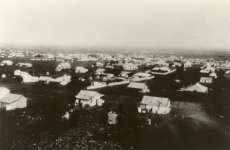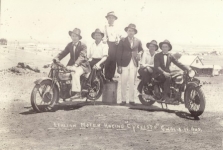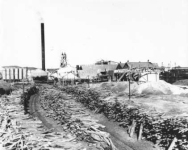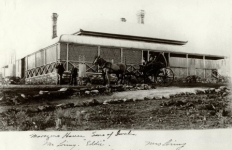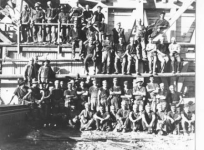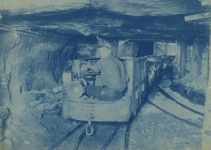A Brief History Of Gwalia And The Sons Of Gwalia Mine
In 1896, the Sons of Gwalia Lease (Lease 190C) was registered in the name of Thomas Tobias, a storekeeper in Coolgardie. The name Gwalia, the ancient poetic name for the country of Wales, was chosen because of Tobias' Welsh heritage. The find was one of many reefs opened up in Gwalia during the year.
The Sons of Gwalia Lease was transferred to G W Hall in 1897 and Sons of Gwalia Ltd was created. Hall erected a second hand 10-stamp battery and 110 men commenced work in June. In those days, miners had to provide their own accommodation and the area around the mine was soon sprinkled with tents and corrugated iron and hessian cottages.
Seeking additional capital, Hall commenced negotiations with a London firm who sent 23 year old mining engineer, Herbert Hoover, to inspect the mine. Hoover recognised its potential and the London and Western Australian Company subsequently took over control of the mine on 17 November 1897. In January 1898, the Sons of Gwalia Company was launched on the London Stock Exchange with Bewick Moreing & Co securing the controlling financial interest. Herbert Hoover was appointed General Manager from 1 May 1898.
In his first week at Gwalia, Hoover increased working hours, introduced single-handed work, instituted shift changes at the working face, and stopped double time on Sundays as well as bonuses for working wet ground. Hoover's strategy was to cut costs by reducing unproductive work time and introducing contract labour. Hoover recruited a number of Italian workers whom he regarded as his allies against the unions: "I have a bunch of Italians coming up ... and will put them in the mine on contract work. If they are satisfactory I will secure enough of them to hold the property in case of a general strike and ... will reduce wages." By the early 1900s and up to the closure of Sons of Gwalia Mine in 1963, a large proportion of the miners were Italian or Yugoslavian.
Hoover oversaw the design of the staff and office buildings on the hill overlooking the mine and growing townsite where the workers lived. He was transferred to China in November 1898 before the majority of the buildings (including the Mine Manager's House) were completed. Hoover went on to become the 31st president of the United States of America.
From the earliest days, there was considerable competition between the ‘towns’ of Gwalia and Leonora. Leonora was gazetted an official townsite in 1897 and developed rapidly. By 1898 there were three hotels, two banks, a telegraph office and many private shops. The government refused to gazette a townsite at Gwalia, arguing that a replication of services only two miles apart was unnecessary. Residential lots were surveyed in Gwalia in 1901 to give some order to the haphazard growth; however, many chose to remain living in a ramshackle settlement close to the mine known as the 'Gwalia Block'. Families tended to live in tin and hessian cottages on the surveyed lots while most single men lived in camps scattered around the mine. The population of Leonora (1,154) exceeded that of Gwalia (1,114) for the first time in 1911. To this day, Gwalia remains a suburb of Leonora.
Despite its lack of townsite status, a general store, a co-operative store, several churches, a school, hall and recreation facilities were built in Gwalia. As well as laying claim to being the home of Australia’s second largest gold mine, Gwalia also boasted Western Australia's first government-owned hotel (1903), the state's first passenger tramway (1903) and the Goldfield's first public swimming pool (1943).
By 1919, the Sons of Gwalia Mine was the deepest mine in Western Australia, with its incline shaft just short of 4,000 feet (1.2 km) in length. By this time, the mine had raised over 3 million tons of ore and continued to be one of Western Australia’s most economical. A serious fire in January 1921 destroyed half of the mine and about 400 men (nearly the entire workforce) were laid off. The combined population of Gwalia and Leonora dropped to just over 1,000.
When the mine re-opened in 1923, there was an influx of people into Gwalia. The Gwalia Co-Operative Store expanded, a butcher's shop with its own piggery, abattoir and refrigerating plant was opened and a picture theatre was established in the AWU Hall. There were a number of boarding houses catering for single men. However, the mine took some years to recover and did not again operate at a profit until the early 1930s.
The fortunes of the mine and town were again on the wane by the late 1950s. The Co-Op Store closed in 1957 and in the same year, Victor Mazza relocated his general store from the Gwalia Block to the main street in the townsite area. The picture theatre closed the following year and by this time, none of the boarding houses were in operation. Mazza's Store, the State Hotel and Patroni's Guest Home are the only surviving commercial buildings in Gwalia today.
After the headframe was damaged on 21 December 1963, it was announced that the mine would close immediately. Trains were despatched from Kalgoorlie and most Gwalia folk virtually walked away, taking with them what they could carry. In just under three weeks, the population of Gwalia dropped from about 1,200 to 40.
Some people chose to remain in Gwalia and today about 20 houses are still lived in. Gwalia is truly one of Australia’s greatest living ghost towns.
